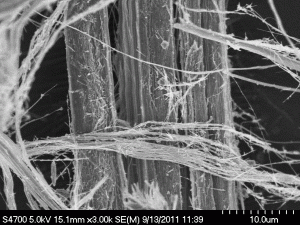Imagine finding out that your home was surrounded by a nano-sized toxicant. You couldn’t see it but it was in the air all around you, and you and your family were breathing it in with every breath. This is unfortunately a reality for people living in communities where Naturally Occurring Asbestos, or NOA, exists. NOA is asbestos that occurs in the soil or geology of a region – it wasn’t put there by human activities.
Asbestos refers to a group of fibrous minerals once considered miraculous due to their suitability for over 3000 industrial purposes, such as insulation and building materials. However, these miraculous minerals also pose a severe health hazard. Asbestos inhalation is linked to lung cancer and mesothelioma, a highly fatal cancer of the chest cavity.
Bundles of chrysotile asbestos, 5000X
Chrysotile, the most common form of asbestos, contains oxidizing metals, such as chromium, nickel, and iron, that are linked to the negative health effects of the fibers. There have been very few studies conducted on NOA chrysotile, and the health risks remain unclear. There is currently no consensus on how hazardous NOA is, or how it should be dealt with.
Asbestos becomes less toxic when the layer containing the oxidizing metals is leached from the surface. Weathering in the natural environment may alter the surface chemistry of asbestos fibers, making them less hazardous.
One of the communities struggling to deal with NOA is the Sumas Prairie in the Lower Fraser Valley. A landslide on Sumas mountain, WA, has been dumping asbestos rock into the Sumas river since the 1970’s. The asbestos material is carried down the river as sediment and deposited on the floodplain during flood events. When the sediment dries out, it can become airborne and pose an inhalation hazard to local residents.
The Sumas River with piles of asbestos laden sediment in front of the local homes.
For my Master’s research, I examined the surface chemistry of asbestos as it moved down the Sumas River, and before and after treatment with naturally occurring acids (oxalic, HCl, and carbonic), to determine if naturally occurring acids in soils and streams are removing the surface magnesium, and thus reducing the toxicity of the asbestos.
As the asbestos moves downstream, the surface chemistry of the asbestos fibers are altered, indicating that natural weathering is likely reducing the toxic effect of the fibers.
We may be able to speed up the rate the asbestos is detoxified by covering the asbestos contaminated floodplains with organic material. Organic material naturally forms organic acids, which over time will leach the heavy metals from the fibers. The organic matter layer will also cover the asbestos material preventing it from becoming airborne. If the fibers aren’t airborne, they won’t be inhaled by residents and thus, will not pose a health hazard.
source: Surface Chemistry of Naturally Occurring Asbestos - understanding its potential health hazard


Since my niece lives hear the Sumas river this is really interesting. Nature has a way of dealing with toxic material and within its limits does clean up. I guess a general rule is that if materials are naturally in our environment, then we tend to evolve with them so they are not toxic to us. Trouble is, we have produced a lot of stuff we did not evolve with.
Hi,
First of all thank you for your research and effort about this NOA and suggested measure!
But I do have some questions about this NOA. First of all this asbestos can become airborne but can this be taken by the wind to other places, across the border and far beyond? Is the air in surrounding places and cities relatively “far” away, like Langley and South Surrey, tested for the concentration of asbestos? I presume that this concentration won’t be sky rocking high but can the continuous exposure to this (“low”) concentration of asbestos be dangerous? I also presume that the direction of the wind can/will influence the dispersion of the airborne asbestos. So is there any clue to witch regions might be most effected?
I read on numerous website that this landslide occur in the 1930’s but none of these mentioned that this dumping of asbestos only started in the 1970’s. Because of the long duration before the associated diseases occur (mesothelioma can take 20 to 30 years!) this can be misleading…. and give a false security to the people!
I only find reports dating from 2005 to the latest of 2010. But is this area still under investigation by the government? Are they still monitoring the percentages of concentration? If there are more recent reports, where can they be found?
Thanks for your time and effort
Your help will be much appreciated
Hello,
These are good questions, and unfortunately the answers aren’t very clear. I am not aware of any sampling for asbestos in places like Langely and South Surrey. A fiber could potentially reach relatively ‘far away’ places, but whether the fibers would be in high enough concentration to pose a serious threat in these areas is the real question. The fiber also may be quite weathered and no longer hazardous once it has traveled such a far distance.
The EPA and Environment Canada are still monitoring the situation, and the EPA is doing a lot of work around determining airborne asbestos levels near the slide. I don’t believe there is much concern for areas removed from the floodplain and slide, likely because the concentrations are so much lower. Here is a link to an EPA site that has information pertaining to activity based sampling in 2012 and 2011. http://yosemite.epa.gov/r10/cleanup.nsf/sites/swiftcreek
I am not sure of the exact time of the slide. I have heard the 1970’s, but you are correct that there is a lot of sources saying it began in the 1930’s. I’m not sure if there was landslide activity starting in the 30’s that has gradually becoming more serious, or if the 1970’s date is incorrect. Thank-you for bringing this to my attention.